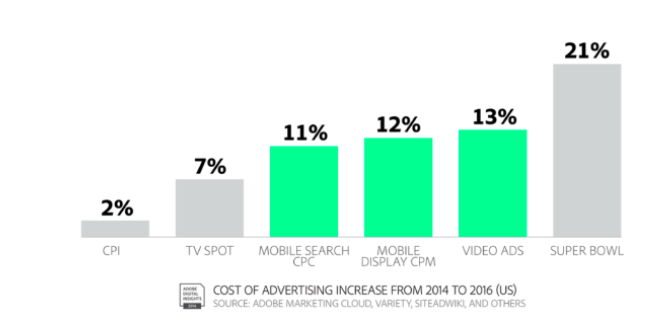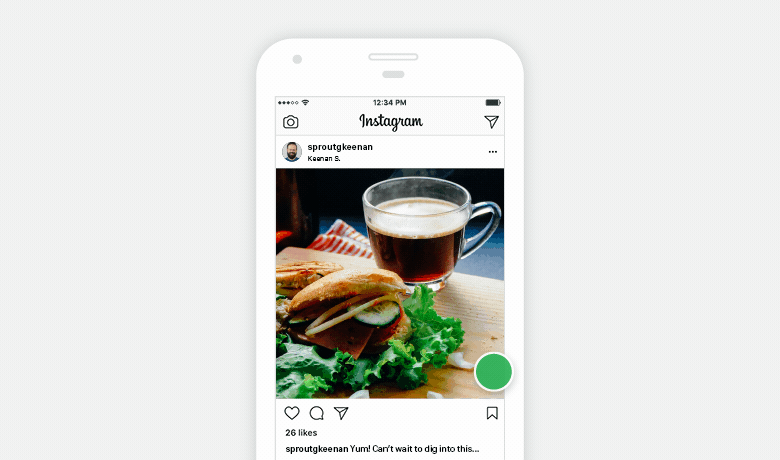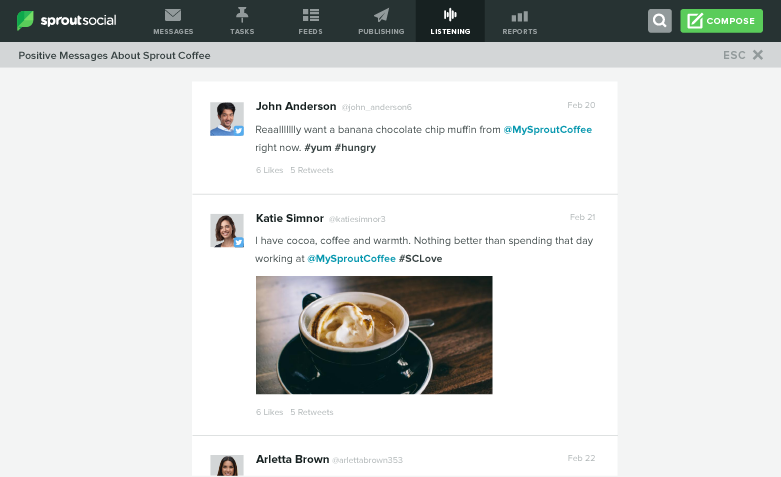Whether it’s through micro influencers, customer advocates or celebrity endorsers, we all have seen the rise of user-generated content on social media.
It shouldn’t be that surprising either. Why? Well let’s start with the fact that Facebook’s newly improved Page Insights for businesses expects some to see a dip in organic reach–even lower than previously accounted.

In fact, the 2017 Digital Advertising Report from Adobe Digital found digital ad costs are seeing growth five times faster than US inflation rates. Getting in front of your target audience is only getting more complex, competitive and expensive.
So where do you go from here?
One way marketers are approaching organic reach is through customer advocacy. By relying on customers and their followers, brands hit home with marketing efforts more effectively. One of the best ways to push customer advocacy is through user-generated content.
This is why we’re here. We want to help you turn your customers into advocates through user-generated content. Follow these five steps get started:
Step 1: Choose the Social Networks Most Effective to Your Campaign
It’s extremely important to not just know where your audience lives on social, but where your potential advocates could have the most influence. You don’t want to jump straight to Instagram because it’s easier to share visuals from your customers.

The social network you choose should be based on your goals and target audience.
Our Q2 2016 Sprout Social Index found about 75% of consumers will share a positive experience with a brand. Consumers are also 70% more likely to make a purchase with a company after a good interaction.
This shows that no matter the social network, a good interaction or positive experience does wonders for your brand. User-generated content doesn’t have to be difficult. Actually, it’s a simple process of asking to repurpose customer content for your brand.

Being mentioned or having content shared by a brand is often fun and exciting for consumers. Their shares not only help you to get to their audience, but you also expose your audience as well. It’s a true win-win when done correctly.
When starting out, try to see what social channels could have the most impact through user-generated content. Focus on the actual benefits that come with shared content.
For example, Square Space’s approach to user-generated content is to show off its advocates’ talents behind the camera. And this makes sense for a brand wanting to connect to more people just like the user here.
Many consumers are twice as likely to share user-generated content with friends or family too. People simply trust one another over brands, which means user-generated content often gets more engagement than promotional posts.
What User-Generated Content Works on Each Network
Choosing the best social network for your campaign is the easy part. But determining what type of user-generated content to post on that specific network is another challenge.
Besides figuring out networks for your audience, it’s necessary to learn about what content works with each network. Try some of these tips to post better user-generated content to each social network:
Facebook: This network is great for sharing video content and stories about your brand. Use Facebook to post the kind of videos likelier to get more engagements with the possibility of going viral. Facebook’s algorithm is tough for organic reach, but don’t rule out posting user-generated content on ads.
Twitter: Despite a smaller character count, you’re not as limited on Twitter as you think. Twitter tends to be a great spot for images, so let the visuals do the talking on this social network. Highly visual user-generated content on Twitter also benefits brands because of its shareability.
Instagram: As the mecca of user-generated content, Instagram often is the go to. It’s critical to know how to regram, use Instagram Explore and find content through hashtags. Seeing products in action makes Instagram a great space for brands to get visual and connect with those who support you.
LinkedIn: As the world’s largest social network for professionals, user-generated content has to be vetted and relevant to your brand’s goals. This isn’t the spot just to repost a user’s content because you liked it. Instead, use LinkedIn to promote above and beyond user content that aligns with your brand.
Step 2: Set Specific User Generated Content Goals
Just like any other content strategy, your user-generated content plan has to have specific goals and guidelines to work its best.
According to SEMrush, 86% of businesses have tried user-generated content, but GoodVid discovered only 27% have a strategy for this content in place. User-generated content sometimes sparks conversations, increases engagement and builds trust. But if used the wrong way, this content will have your followers packing up and leaving.
That’s why you have to–like any sort of marketing campaign–create goals. Here are some common user-generated content goals marketers set in place:
- Higher Brand Engagement: Everyone wants more likes, but setting engagement as a goal is smart during UGC campaigns. Influencers tend to spark conversation with their content. Seeing more comments, likes and mentions toward your channels shows signs of success. But you need the right social media analytics tools to benchmark your efforts!
- Increased Conversion Rates: Need to reassure consumers’ purchasing decisions? UGC has the power to help consumers on the fence with your product. If you’re in even a slightly competitive industry–people will do their research. Make it your priority to increase conversions with reviews, unboxing showcases and social media takeovers for your campaign.
- Building Brand Trust: Another common goal is simply getting folks to trust you. Whether you’ve had some bad press or you’re starting fresh, building brand awareness through trust is a great goal. So how do you measure it? UGC establishes credibility with consumers, so try to track keywords or phrases you know are associated with your brand. Then track and measure to see if people are giving more positive feedback on social or even on reviews.

- Educating More Users: Start by tracking common questions and concerns about your business on social media. By listening to conversations, you can measure whether the same questions are being asked before and after your UGC campaign. Influencers do a great job of cutting through and providing a clear answer.
- Save Time on Content Creation: If your team is in need of more social content, UGC can help save a lot of time. By aggregating hashtags, comments and photos, you save time in the creation process.
Step 3: Tell Your Audience What Content You Want
If you’re not flat out telling your audience to participate with user-generated content, how else will they know? Make it clear and specific what types of content you’re looking for and what aligns best with your brand.
Whether you’re asking for images or customers’ thoughts, your advocates need the proper guidance. Without a clear goal and ask of your audience, you might confuse users or get a ton of the wrong content.
Try to be as specific as possible with brand rules and regulations toward user-generated content. If you want people to send content to you, more than likely they will. But how much of it is usable if you didn’t state clearly what you wanted?
It’s also important to not lose your focus. If you want a specific style of content, don’t revise or change your plans after a few short days. Getting people to share user-generated content with you takes time. If you rush it, you could end up creating a negative experience.
What’s worse is without good guidelines or content specifics, you’re extremely susceptible to internet trolls. Make sure you check hashtags and your guidelines to leave little room for errors. Otherwise, you’re giving trolls exactly what they want–a chance to use your words against you. Simply be smart and take your time with user-generated content.
A Better Way to Manage Social
Choose a Type of User-Generated Content
You have numerous ways to apply user-generated content to your marketing strategy. A popular way to generate non-branded content is through social media contests. But that isn’t the only thing you can do.
Another popular type of user-generated content is with campaign hashtags. Hashtags can get your audience involved with your message or campaign. For example, Yeti recently released its “Charcoal Collection” while using #BuiltforTheWild.
Even though your ultimate goal is to promote your brand, you could do this by simply using a beautiful photo that relates to your brand. This type of content drives users to follow, engage and send content further down the line.
Once you have the content, try using Sprout’s own Instagram Repost features. Here, you easily share your favorite user-generated content on Instagram with a few taps.

It’s a breeze to simply copy the link of the post, open your Sprout Social app, schedule or post immediately and then share.
Driving more awareness to your social channels will not only direct people to your products or services better, but it will also show them your brand’s personality.
Step 4: Focus on the Community Aspect & Collaborate
The best thing about user-generated content is it typically sparks engagement. That means you have to put emphasis on building your community. As a community manager, you have to create a persona for the brand and connect customers and advocates.
User-generated content brings the chance to connect with new people through conversation. Your whole point is to build credibility. And if done correctly, you’ll drive users down the marketing funnel.
Your followers are extremely important to your social media strategy, so treat them well. Answer questions, give recognition, be there during product launches and show your human side. Users know there’s someone sitting behind the screen, so give your brand a personality that engages.
Don’t treat social media engagement as a chore, but instead as an opportunity.
Don’t Take Without Asking
It should go without saying, but far too often, brands think they can simply take images from a site and give credit to the photographer or influencer without any agreement. This is wrong.
Always make sure you’re in agreement with users before you share their content. As this viral story goes, it’s not fair to take people’s hard work and use it without paying or agreeing on something first.
This doesn’t mean you have to pay for every piece of user-generated content. However, if someone asks for a payment, you can either work out an agreement or look for users who would be willing to trade for the exposure. Just always remember to ask before sharing and don’t be shocked if they ask for money.
This doesn’t mean you have to pay for every piece of user-generated content. However, if someone asks for a payment, you can either work out an agreement or look for users who would be willing to trade for the exposure. Just always remember to ask before sharing and don’t be shocked if they ask for money.
Step 5: Analyze & Measure Your User Generated Content Efforts
We’ve said this already, but let’s bring it home. If you want your user-generated content strategy to work, you have to measure it. No matter what you choose for goals or how you plan your attack, you need to benchmark.

With Sprout Social, you have social media analytics tools to track your overall engagement with user-generated content. Whether you’re posting to Facebook, Twitter, LinkedIn or Instagram, you have access to detailed audience reports.

Additionally, our social listening tools let you leverage your social data by gaining insights into valuable analysis. Whether it’s contextual analysis of keywords, hashtags or customer experiences, these powerful social tools let you measure your efforts.
Don’t miss a great opportunity to share user-generated content because you missed someone using your brand in a hashtag. User-generated content is tricky, but if you follow the steps above, you can use it to your brand’s advantage.
Take this opportunity as a chance to engage more with your audience and build a better community among your followers.
